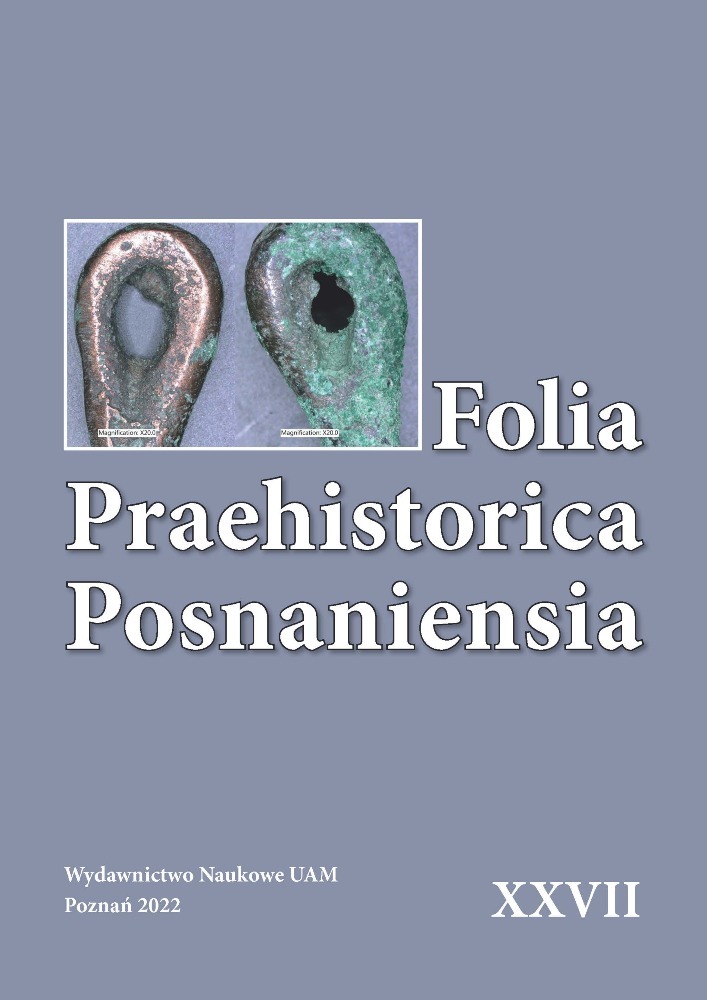Abstrakt
This paper is a discussion of the theoretical conceptualization of past landscapes and the limitations of archaeology in providing objectivistic interpretations. Analyzing a case study of the Dewil Valley landscape I will argue that the sciences about the past emerged based on the “Western” research paradigm. Therefore, local ontologies are often overlooked in archaeological narratives. In this article, I will present the ontologies of the indigenous Tagbanua people, contemporary beliefs related to the landscape, and theoretical approaches presented by researchers. I will argue that ontology can be complex and ambivalent, and that archaeological sources do not always indicate these dynamics.
Bibliografia
Andrzejewski, A., Salwa, M. (2020). The Ontology of Landscapes. Rivista di Estetica, 75, 164-182. Bennagen, P. L. (1980). The Asianisation of Anthropology. Asian Studies, 18, 1-26. https://doi.org/10.4000/estetica.7426 DOI: https://doi.org/10.4000/estetica.7426
Cosgrove, D., Daniels, S. (1988). The Iconography of Landscape: Essays on the Symbolic Representation, Design and Use of Past Environments. Cambridge: Cambridge University Press.
Cuevas, S. M. M., Fernandez, J. E. C., Olvida, I. (2015). Where peasants are kings: Food sovereignty in the Tagbanua traditional subsistence system. ASEAS - Austrian Journal of South-East Asian Studies, 8(1), 27-44.
Dressler, W. (2005). Disentangling Tagbanua lifeways, Swidden and conservation on Palawan. Human Ecology Review, 12(1), 21-50.
Fahlander, F. (2017). Ontology matters in archaeology and anthropology. People, things and posthumanism. In J. D. Englehardt, I. A. Rieger (eds.), These "Thin Partitions". Bridging the Growing Devide between Cultural Anthropology and Archaeology (p. 69-86). Boulder: University Press of Colorado. https://doi.org/10.5876/9781607325420.c003 DOI: https://doi.org/10.5876/9781607325420.c003
Flieger, W. (1977). Internal migration in the Philippines during the 1960's. Philippine Quarterly of Culture and Society, 5(4), 199-231.
Fox, R. (1982). Religion and Society Among the Tagbanuas of Palawan Island, Philippines. Manila: National Museum.
Gell, A. (1975). Methamorphosis of the cassowaries: Umeda society, language and ritual. London: University of London, Atnlone Press; New Jersey: Humanities Press, Inc.
Hamilakis, Y. (2013). Archaeology and the Senses: Human Experience, Memory, and Affect. Cambridge University Press. https://doi.org/10.1017/CBO9781139024655 DOI: https://doi.org/10.1017/CBO9781139024655
Hirsch, E. (2006). Landscape, Myth and Time. Journal of Material Culture, 11, 151-156. Ingold, T. (1993). The Temporality of the Landscape. World Archaeology, 25(2), 152-174. https://doi.org/10.1177/1359183506063018 DOI: https://doi.org/10.1080/00438243.1993.9980235
Kambaskovic-Sawers, D., Wolfe, C. (2014). The Senses in Philosophy and Science: From the Nobility of Sight to the Materialism of Touch. In H. Roodenburg (ed.), A Cultural History of the Senses in the Renaissance (p. 107-125). United Kingdom: Bloomsbury. https://doi.org/10.5040/9781474233217.ch-005 DOI: https://doi.org/10.5040/9781474233217.ch-005
Latour, B. (1993). We have never been modern. Cambridge, Massachusetts: Harvard University Press. Latour, B. (2005). Reassembling the Social: An introduction to Actor-Network-Theory. Oxford: Oxford University Press.
Lydon, J. , Rizvi, U. (eds.) (2010). Handbook of Postcolonial Archaeology. Walnut Creek: Left Coast Press.
Macdonald, C. J. H. (1992). Invoking the Spirits in Palawan: Ethnography and Pragmatics. In H. Bolton, H. Kwok (eds.), Sociolinguistics Today (p. 244-260). London: Routlege.
Macdonald, C. J. H. (2004). Folk Catholicism and Pre-Spanish Religions in the Philippines. Philippine Studies, 52(1), 78-93.
Menoro, M., Tablizo A. (2017). The Modern World: Exploring the Culture of Tagbanua Tribe in Palawan. International Journal of Novel Research in Interdisciplinary Studies, 4(2), 15-26.
Novellino, D. (2003). Contrasting Landscapes, Conflicting Ontologies: Assessing Environmental Conservation on Palawan Island (The Philippines). In D. G. Anderson, E. Berglund (eds.), Ethnographies of Conservation: Environmentalism and the Distribution of Privilege (p. 171-188). New York: Berghahn Books. https://doi.org/10.1515/9780857456748-014 DOI: https://doi.org/10.1515/9780857456748-014
Ocampo, N. (1996). History of Palawan. In J. F. Eder, J. O. Fernandez (eds.), Palawan at the crossroads: Development and the environment on a Philippine frontier (p. 23-37). Quezon City: Ataneo de Manila Press.
Odal Devora, G. (2006). Some problems in determining the origin of the Philippine word 'mutya' or 'mutia'. Tenth International Conference on Austronesian Linguistics, 1-14 (an unpublished article). Olsen, B. (2010). In Defense of Things. Archaeology and the Ontology of Objects. Lanham: AltaMira Press.
Olwig, K. R. (1996). Recovering the Substantive Nature of Landscape. Annals of the A.A.G, 86(4), 630-653. https://doi.org/10.1111/j.1467-8306.1996.tb01770.x DOI: https://doi.org/10.1111/j.1467-8306.1996.tb01770.x
Palecek, M., Risjord, M. (2012). Relativism and the Ontological Turn within Anthropology. Philosophy of the Social Sciences, 43(1), 3-23. https://doi.org/10.1177/0048393112463335 DOI: https://doi.org/10.1177/0048393112463335
Paz, V. (2012). Accessing past cosmologies through material culture and landscape in the Philippines. In K. Rountree, C. Morris, A. A. D. Peatfield, (eds.), Archaeology of Spiritualities (p. 133-162). New York: Springer. https://doi.org/10.1007/978-1-4614-3354-5_7 DOI: https://doi.org/10.1007/978-1-4614-3354-5_7
Paz, V., Lewis, H., Ronquillo, W., Robles, E., Carlos, J., Lara, M., Choa, O., Tiauzon, A., O'Donell, S., Hernandez, V., Cuerdo, D., Foster, G., Marciani, G., Solheim II, W. (2014). The Palawan Island Paleohistoric Research Project. Report on 2014 Season. Manila.
Povinelli, E. A. (2016). Geontologies: A Requiem to Late Liberalism. Durham: NC Duke University Press. Ramos, M. D. (1971). Creatures of Philippine Lower Mythology. Philippines. Manila: Create Space Independent Publishing Platform.
Smith, M. M. (2015). The Smell of Battle, the Taste of Siege: A Sensory History of the Civil War. United States: Smithsonian Libraries.
Smyrski, Ł. (2017). Antropologia krajobrazu - na pograniczu dyscyplin. Etnografia Polska, 61(1-2), 125-146.
Theriault, N. (2015). A forest of dreams: Ontological multiplicity and the fantasies of environmental government in the Philippines. Political Geography, 58, 114-127. https://doi.org/10.1016/j.polgeo.2015.09.004 DOI: https://doi.org/10.1016/j.polgeo.2015.09.004
Thomas, S. (2017). Documenting Indigenous Tagbanua Practices That Support Environmental Conservation in Palawan, Philippines (an unpublished MA thesis).
Tilley, C., Bennett, W. (2004). The materiality of stone: explorations in landscape phenomenology. Oxford: Bloomsbury.
Tilley, C., Cameron-Daum, K. (2017). Anthropology of Landscape: The Extraordinary in the Ordinary. London: University College London. https://doi.org/10.2307/j.ctt1mtz542 DOI: https://doi.org/10.2307/j.ctt1mtz542
Todd, Z. (2019). Reading Povinelli in the shadow of the Alberta Tar Sands: Thinking wahkohtowin into disruptions of late liberalism. Geontographies: On Elizabeth Povinelli's Geontologies: A Requiem for Late Liberalism, 1, 5-14.
Tilley, C. (1994). A Phenomenology of Landscape: Places, Paths and Monuments. Oxford: Berg Publishers.
Venturello, M. H., Miller, E. (1907). Manners and customs of the Tagbanuas and other tribes of the island of Palawan, Philippines. Washington: Smithsonian Institution.
Wylie, J. (2007). Landscape. London: Routledge. https://doi.org/10.4324/9780203480168 DOI: https://doi.org/10.4324/9780203480168
Licencja
Prawa autorskie (c) 2022 Zuzanna Kowalczyk

Utwór dostępny jest na licencji Creative Commons Uznanie autorstwa 4.0 Międzynarodowe.
